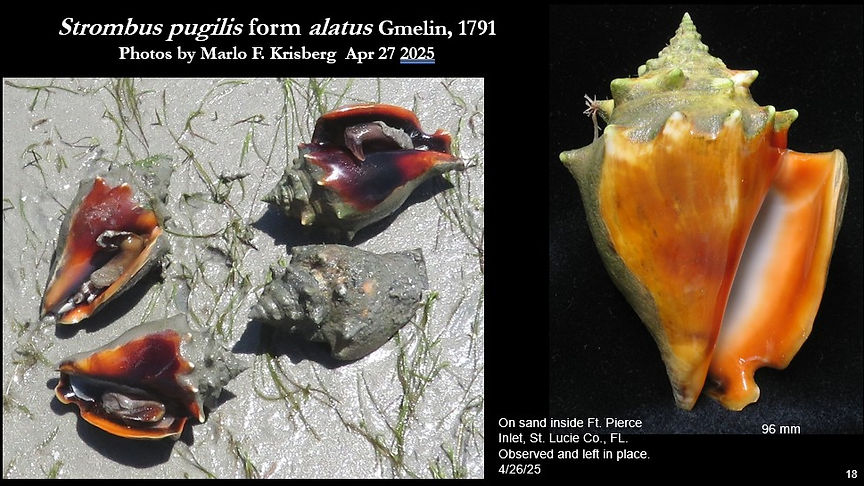
Posted: Aug 2 2007; Updated Jun 2025
Strombus pugilis Gmelin, 1791, Florida Fighting Conch Previously Strombus alatus Gmelin, 1791
Oct 2024: A recent paper* using COI barcoding gene support concluded that Strombus alatus Gmelin, 1791 and Strombus pugilis Linnaeus, 1758 were genetically the same, and the authors synonymized the two. The result would be that S. alatus would then become a junior synonym to S. pugilis. WoRMS and iNaturalist have recognized this change.
*Irwin, Bouchet, Crame, Harper, Kronenberg, Strong, and Williams. Jul 2024. Molecular phylogenetics of the superfamily Stromboidea (Caenogastropoda): New insights from increased taxon sampling. Zoologica Scripta, Vol. 53, Issue 6. See section 3.4.
The shell we’ve been calling Strombus alatus until Irwin, et al.’s 2024 paper is the most common Stombidae found around Florida. It is found on both sides of the peninsula and the Florida Keys. Though very similar to the Caribbean S. pugilis Linneaus, 1758, it has a consistently different morphological appearance. The Caribbean S. pugilis is also reported as occurring in Florida. However, it has been suggested, and I would concur, that the Caribbean S. pugilis is not native to Florida, rather it is a Caribbean species that has reached the Florida peninsula and interbred with Florida's S. alatus. In my experience there is only one apparent location where the Caribbean S. pugilis and it's hybrids occur in Florida - Palm Beach County on Florida’s east coast. In this area specimens can be found clearly having the characteristics of either S. alatus or the Caribbean S. pugilis, as well as specimens with characteristics of both. This presentation is intended to present the Floridian form of S. pugilis. Older slides have not been updated and reflect the name Strombus alatus Gmelin, 1791. Slides added since 2024 reflect the name Strombus pugilis form alatus Gmelin, 1791.
S. pugilis is treated in a separate presentation. A comparison of the two is presented at the end of this presentation.



















CLICK HERE for many more images.


was collected near




6/16/12 schmidee:
I am an archaeologist working on the Florida Gulf Coast, and I'm hoping the LTS community can help me figure something out.
I am currently working at an archaeological site that has patches of dense shell refuse ("midden"), typically a combination of Strombus alatus, Busycon sinistrum, Argopecten irradians, Pleuroploca gigantea, Macrocallista nimbosa, and a few other species.
But some of the patches are almost exclusively (99%) S. alatus, of uniform (adult) size. What could explain this? Collecting these guys in such large numbers seems difficult. I have looked for live S. alatus in the surrounding area, and have had no success. I suspect they are around, as I've seen hermit crabs occupying dead S. alatus shells.
(1) Does anyone know of live S. alatus forming dense aggregations, as S. gigas does?
(2) Are they typically observed moving along the surface of the substrate, or are they normally buried within the substrate? (Maybe my failure to find them was a matter of technique?)
I look forward to hearing your thoughts! Thanks!
6/29/12 Susan Hewitt:
Strombus alatus lives quite densely on sand bars which are not quite subtidal but which are usually not exposed to the air except during minus tides that occur with the full moon and new moon. At those times, in places where there is really good habitat, like on the Gulf Coast of Sanibel, it would in theory be very easy to collect hundreds and hundreds of live adult individuals in quite a small area of a few hundred meters. I have written a paper which mentions some aspects of the behavior of this species and it might be relevant to your studies. This paper is currently "in press" at the journal "Festivus". The paper hopefully will be coming out before the end of this year.
6/30/12 schmidee:
Thank you, that's great information. I'll try to get my hands on that paper when it comes out!
12/28/14 Mike:
In your description of Strombus alatus, you mentioned that
the body whorl is smooth. I am presently working on my Upper
Pleistocene collection including Strombus alatus from the Fort
Thompson Formation of South Florida. I have a single specimen
which has strong spiral structure over the entire shell. Undoubtedly
some would probably call this a subspecies of S. alatus, but I am
much more conservative in my identifications. I would like to know
if present populations of S. alatus contain individuals with this
variation?
12/29/14 Marlo:
The spiral cords are present in juveniles and sometimes around
the base area in adults, but I don't recall adults with cording over
the entire adult body whorl. Note the 85.7 mm specimen from
Judge Jolly Bridge and the 85.4 mm specimen from Content Keys
in slides above.
3/4/16 Rusty:
Seem like they are very common gulf side and also in fossils there found plenty of fossils of this Tampa bay. Uncommon keys at least for me. Rare to non-existing treasure coast never found one not even a broken piece. Hermit crabs in Indian river fort pierce inlet doesn't use them. Fossils treasure coast rare maybe juvenile but not sure. Found a hermit crab with S. alatus shell at fort pierce a few years ago.



